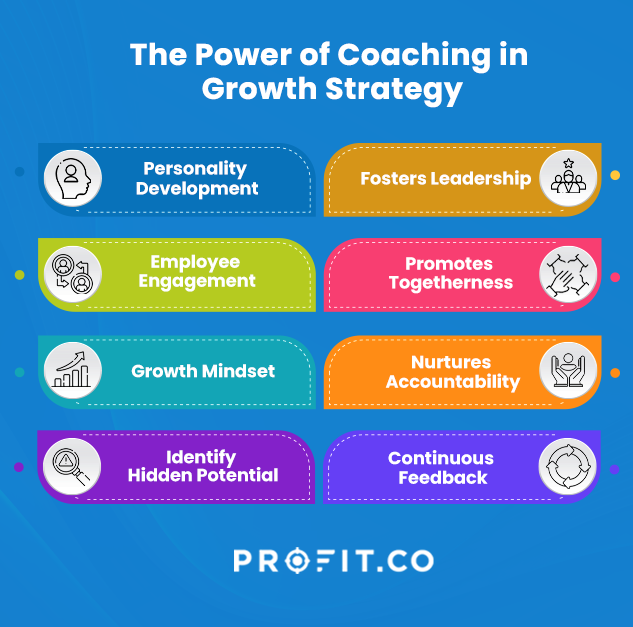Getting Started
As a leader, one of your most important responsibilities is to coach your team to success. Executive coaching produced a 788% ROI for a Fortune 500 company, says the bizGroup. So, how do you do it at your best? Coaching is more than telling your employees what to do or how to do it. Coaching is helping them discover their potential, develop their skills, and achieve their goals. Coaching also creates a culture of excellence where your team members are motivated, engaged, and committed to delivering high-quality results.
Despite having some idea about coaching your team, you might get questions like, how do you become an effective coach for your team? How do you assess their strengths and weaknesses, set clear and measurable goals, provide constructive feedback, motivate and inspire them, delegate and empower them, foster collaboration and trust, celebrate successes, and learn from failures? Do not worry; the answers to these questions are just a few words away!
To begin with, we should understand that, in a constantly evolving business landscape, leadership is not just about giving directives and measuring performance. It’s about coaching, mentoring, and guiding your team to realize their full potential. The role of a leader has evolved from a taskmaster to a coach – someone who can tap into the strengths of each team member, foster a growth mindset, and build a cohesive, high-performing team. In this blog, you will explore the core of successful team coaching, guiding each member towards a path of collective victory.
Navigating the Potential of Coaching as a Growth Strategy
Organizations consistently search for ways to improve performance, enhance employee satisfaction, and achieve sustainable growth. Among the various strategies that have emerged, coaching stands out as an incredibly effective approach to driving both personal and organizational progress. Here’s how coaching can be a powerful growth strategy:
- Personalized development
Unlike one-size-fits-all training programs, coaching is tailored to the individual. A coach identifies the unique strengths and areas of improvement for each person, providing a customized development plan that ensures more significant growth and progress. - Enhancing employee engagement
When employees feel that the organization invests in personal growth, their engagement levels soar. They are more motivated, dedicated, and committed to the company’s goals, driving better overall performance. - Promoting a growth mindset
A hallmark of coaching is the cultivation of a growth mindset. Coaches encourage individuals to see challenges as learning opportunities, promoting resilience, adaptability, and a continuous desire to learn and grow. - Unlocking untapped potential
Even the most talented individuals can have blind spots or unexplored areas of potential. A coach can bring these to light, providing feedback and strategies to leverage these hidden strengths for personal and organizational benefit. - Boosting leadership skills
As individuals rise within an organization, leadership skills become crucial. Coaching equips them with the tools to lead effectively, from improved decision-making to better team management. - Enhancing communication and collaboration
Coaching isn’t just about personal growth; it’s about improving interpersonal dynamics. Through coaching, individuals learn to communicate, understand team dynamics better, and collaborate more efficiently. - Encouraging accountability
One of the cornerstones of coaching is accountability. Coaches ensure that individuals stay on track with their goals, regularly checking in on progress and ensuring that setbacks are turned into learning opportunities. - Continuous feedback and Improvement
Instead of annual reviews, coaching provides continuous feedback, ensuring that individuals can make real-time adjustments to their strategies and actions. This consistent loop of feedback and improvement drives rapid growth.

Understanding Coaching: Myths and Realities
Coaching, especially in the professional and personal development spheres, has gained significant traction in recent years. However, as its popularity rises, so do misconceptions about its purpose, process, and benefits. Let’s debunk some common myths and set the record straight about the realities of coaching.
Myth: Coaching is only for people who have problems or need fixing
But in reality, Coaching is not a form of therapy or counseling. It is a collaborative process that helps people identify their strengths, clarify their vision, overcome challenges, and take action to achieve their desired outcomes.
Myth: Coaching is telling people what to do or giving advice
But the fact is, coaching is not about imposing one’s own opinions or solutions on others. It is about asking powerful questions that help people discover their answers and insights. Coaching is not about giving advice but rather helping people find the best way forward for themselves.
Myth: Coaching is a one-time event or a quick fix
Coaching is a process that requires time, commitment, and follow-up. It is not a magic bullet that can solve all problems in one session. Coaching creates lasting change and sustainable results through regular and consistent support and feedback.
Myth: Coaching is only for executives or high-performers
Coaching is for anyone who wants to achieve more in their personal or professional life. Coaching can help people at any level of their career, from entry-level to senior management, as well as entrepreneurs, students, parents, artists, athletes, and more.
Myth: Coaching is expensive and inaccessible
Coaching is an investment in oneself that can have a high return on value. Coaching can help people save time, money, and energy by helping them avoid costly mistakes, make better decisions, and achieve their goals faster and easier. Coaching can also be affordable and accessible through various online platforms, group coaching, peer coaching, or self-coaching.
Everyone needs a coach. It doesn’t matter whether you’re a basketball player, a tennis player, a gymnast or a bridge player.
Guiding Your Team Through Problem-Solving
Guiding your team through problem-solving is an important skill for any leader or manager. Problem-solving is finding and implementing solutions to complex or challenging issues. It involves identifying the problem, analyzing it, generating possible solutions, evaluating them, and choosing the best one.
There are many benefits of involving your team in problem-solving, such as:
- Improving communication and collaboration among team members
- Enhancing creativity and innovation by tapping into diverse perspectives and experiences
- Increasing ownership and commitment by empowering team members to contribute and implement solutions
- Boosting morale and motivation by celebrating successes and learning from failures
- Developing critical thinking and decision-making skills among team members
However, guiding your team through problem-solving can be challenging. It requires careful planning, facilitation, and follow-up.
Follow this order to lead your team toward problem-solving effectively.
1. Identify a leader
2. Choose team members carefully
3. Give time for preparation
4. Develop clear objectives
5. Create an agenda

Start with a sharp leader and a handpicked dream team. Chart your course with clear goals and a laser-focused agenda, transforming challenges into triumphs with every tick of the clock! All the best!
Setting Ambitious Goals for Your Team
Setting ambitious goals for your team can lead to significant growth, innovation, and performance improvement. However, it’s crucial to ensure these goals are motivating and attainable rather than overwhelming.
Here’s a 8 step guide on how to set ambitious yet achievable goals for your team:
1. Understand your team’s potential
Reflect on past projects or challenges. Did your team meet, exceed, or fall short of expectations? Before setting any goals, evaluate the skills, experiences, and capabilities of your team members. Understanding what they can offer will give insight into how ambitious your goals can be.
2. Align with organizational objectives
According to Forbes, one of the best ways to set ambitious goals for your team is to get to know your business intimately, including its strengths, weaknesses, opportunities, and threats. Ensure that the ambitious goals align with the broader objectives of the organization. This creates a unified focus and maximizes the impact of the team’s efforts.
3. Invest in OKRs
According to Forbes, it is wise to collaborate and implement OKRs, which stand for objectives and key results. OKRs are a popular framework for setting and tracking goals, used by companies like Google, Netflix, and Spotify. Goal-setting tools like Profit.co, help you to start implementing OKRs right away.
Set your OKRs today with Profit.co!
4. Set SMART goals
Use the SMART framework to ensure clarity. SMART stands for Specific, Measurable, Attainable, Relevant, and Time-bound. These criteria help you create clear and concrete goals that are easy to track and evaluate.
5. Break down large goals
Large, ambitious goals can be daunting. Break them down into smaller, more manageable tasks or milestones. This makes progress more visible and boosts motivation.
6. Celebrate milestones
As your team makes progress, celebrate the small wins. This boosts morale and motivation, reinforcing a positive attitude towards ambitious objectives.
7. Foster a growth mindset
Promote an environment where challenges are seen as opportunities to learn and grow rather than threats. Encourage risk-taking (within reason) and learning from failures.
8. Ensure psychological safety
Allow team members to voice concerns, ask questions, or suggest changes without fear of retribution. A safe environment fosters innovation and creative problem-solving. You can look for a mentor or coach within your organization, network, or industry or use platforms.
Enhancing Performance and Growth
As a leader, you want to coach your team to success. You want to help them achieve their goals, develop their skills, and unleash their creativity. To do that, you must combine three key elements: hard work, smart planning, and a flexible mindset. You need to support your team members, encourage them to learn new things and foster a culture of innovation. You need to push them to overcome their challenges, adjust to the changing conditions, and realize their full potential. By doing this, you will not only boost their performance and growth, but also your own and your organization’s.
Gaining a Competitive Edge with Coaching
Gaining a competitive edge through coaching is about leveraging the transformative power of personalized guidance and support. It’s a strategic advantage, providing individuals and teams with the insights and accountability needed to outperform themselves and, by extension, outmaneuver the competition. Effective coaching hones latent talent, fosters critical thinking, and cultivates a high-performance culture that translates into measurable success in any arena.

Final Thoughts
Coaching is mandatory for a thriving team. It’s a continuous commitment to developing your team’s abilities to ensure they and the organization can reach their full potential. As you integrate coaching into your leadership style, remember it’s a journey. There will be learning curves and setbacks, but these, too, are opportunities to coach and be coached. The ultimate reward is a team that’s not only successful but also self-reliant, innovative, and perpetually driving toward excellence.

